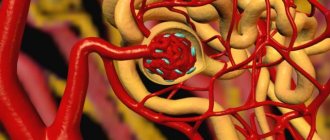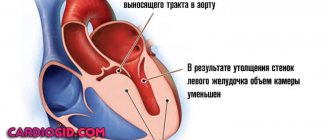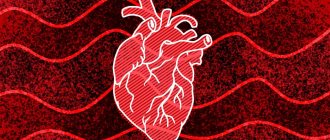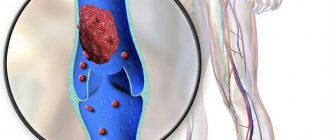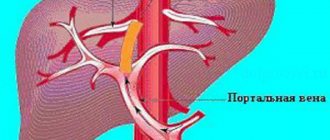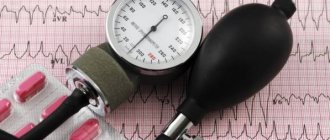If blood circulation in the renal arteries is impaired and pressure increases, “renovascular hypertension” is diagnosed. The disease develops over many years and never appears unexpectedly. This is not the most common type of hypertension, but it is one of the most dangerous. The disease is more aggressive; malignant forms are often found, which lead to death. Renovascular hypertension requires rapid medical intervention in order to cure the disease at the initial stage. In the malignant form, surgery may be required.
Renovascular hypertension - what is it?
Currently, pathologies of the cardiovascular system are increasingly diagnosed not only in older people, but also in representatives of the younger generation. This is due to the negative influence of various factors: hereditary predisposition, bad habits, and the presence of chronic diseases. The disease can cause the development of other similar pathologies. One of these diseases is renovascular arterial hypertension.
The syndrome occurs against the background of narrowing of blood vessels in the kidneys and deterioration of blood circulation. In the absence of timely treatment, the disease can lead to tissue ischemia and renal failure. The disorder is diagnosed only in a small number of patients with problems with blood pressure. Renovascular hypertension can affect one or both kidneys.
Diagnostics
Timely diagnosis allows us to identify renovascular hypertension at an early stage, which allows us to eliminate the causes of the development of the pathology and prevent the progression of the disease.
With selective angiography of the renal arteries, the main factors that led to the development of pathology are determined. The study reveals the location and extent of vascular damage. This diagnostic method is the most reliable.
Study of blood plasma for renin - material is taken from the renal vessel on the side of the damaged organ. A high renin content indicates the presence of vascular pathology.
Other research methods:
- Ultrasound, MRI, kidney biopsy;
- plain X-ray examination;
- excretory urography;
- radioisotope renography.
Pathogenesis
According to studies conducted by specialists, narrowing of the renal artery causes increased synthesis of renin, a component that regulates blood pressure and is responsible for reducing the volume of peripheral blood vessels. This is necessary to normalize the blood supply to the kidney. However, the narrowed lumen of the artery does not allow blood flow to improve.
Simultaneously with this process, increased activity of aldosterone and angiotensin in the blood is observed. The first substance is a hormone secreted by the adrenal glands. It is released by angiotensin (an olegopeptide hormone) and affects only the healthy kidney, reducing urine production due to sodium retention. This prevents the kidneys from fully performing their functions of purifying the blood and causes the development of a disease such as renovascular arterial hypertension.
The pathogenesis of the disease gives an idea of how the syndrome arises and what needs to be done to restore proper kidney function. With complete normalization of blood circulation in the affected vessels, the patient’s condition improves and the disease recedes.
Prevention
After treatment is completed, it is necessary to adhere to a special diet with a minimum amount of salt, regularly take medications to normalize blood pressure, and avoid hypothermia.
People with renal artery pathology should lead a healthy lifestyle - completely give up bad habits, perform moderate physical activity, and regularly exercise.
In the natural course of renovascular arterial hypertension, the prognosis of the disease is unfavorable. Against this background, irreversible pathologies develop in the blood vessels and heart. Modern methods of traditional treatment have a radical effect on the development of the disease. But everything depends on correct and timely diagnosis.
Causes of the disease
Currently, doctors name several main reasons that can serve as an impetus for the development of the pathological condition. Vasorenal (renovascular) hypertension most often occurs against the background of the following diseases:
- Atherosclerosis is the main cause of the development of nephrogenic arterial hypertension. Cholesterol plaques narrow the lumen of blood vessels by approximately half at the point of entry into the kidney. The disease most often affects men aged 40-55 years. In women, the pathology usually appears after 60 years.
- Fibromuscular dysplasia of the renal arteries is an inflammatory process in which the structure of the muscle tissue of the vessels changes. Hyperplasia often occurs in young people, as well as in childhood. In addition to hyperplasia of muscle elements, the formation of microaneurysms is observed. The etiology of fibromuscular dysplasia is unknown.
- Takayasu's disease is a syndrome associated with inflammatory processes in the aorta and the formation of a blood clot. The disease is also called pulseless disease. The narrowing of blood vessels is caused by thickening of the vascular membranes against the background of destruction and swelling of vascular tissue. The disease is of autoimmune etiology.
- Mechanical compression of blood vessels occurs against the background of the formation of tumors, cysts and vascular aneurysms. When blood flow is disrupted, renovascular hypertension develops. What it is and how to deal with this disease will be discussed below.
Reasons for development
Renovascular hypertension develops in 20 different diseases, but most often its cause is atherosclerosis of the renal artery and its branches. As statistics show, clinical manifestations of pathology bother the patient when the lumen of the vessel narrows by 50% or more. In this form of the disease, atherosclerotic plaques form in the proximal third of the artery or at its mouth.
The second common cause of such hypertension is fibromuscular dysplasia. A genetic disease leading to a deficiency of muscle and connective tissue. Most often it is diagnosed in young women. Doctors distinguish several types of pathology:
- medial (the middle part of the vessel is damaged);
- intimate (the inner part of the vessel suffers);
- perimedial (the outer shell is changed);
- periarterial.
On an angiogram (examination of blood vessels), it is easy to distinguish this pathology from others - areas of narrowing of the arteries alternate with aneurysms, which gives the vessel the appearance of beads.
Other reasons for which renovascular hypertension develops: Takayasu’s aortoarteritis, neoplasms compressing the renal artery, its embolism or thrombosis. As well as congenital anomalies of the artery or kidneys, nonspecific aortoarteritis and panarteritis (inflammatory pathologies of the arteries), chronic kidney diseases. Risk factors include bad habits, a predisposition to hypertension, diabetes, old age, high cholesterol, and a diet high in salt.
Regardless of the cause of hypertension, the mechanism of its development is the same. Reduced vascular capacity provokes the production of large amounts of the enzyme renin. It is formed in the cortex of the kidney. Once in the blood, renin combines with angiotensinogen to form angiotensin. It is he who affects the blood vessels, causing them to narrow, and accordingly increasing the pressure.
Clinical picture
Symptoms of the disease include signs of arterial hypertension and kidney pathologies. The severity of the clinical picture of the disease depends on the course of renovascular hypertension and the factors that led to its development. With the rapid development of characteristic symptoms, they speak of a malignant type. If the pathology develops slowly, the disease is benign.
In most cases, severe renovascular hypertension is diagnosed. The symptoms of the disease are as follows:
- consistently high blood pressure levels that do not decrease even with the use of medications;
- increased diastolic pressure against the background of normal systolic values;
- myocardial hypertrophy;
- increased pressure due to sharp pain in the lumbar region;
- murmur when listening to the renal arteries.
At a young age, sudden jumps in blood pressure should be alarming. This is especially true in cases where immediate relatives did not suffer from arterial hypertension and the disease could not be inherited.
General information about the disease
Hypertension can be primary and secondary (false). True primary (essential) hypertension develops against the background of regular vascular spasms, during which adrenaline is released. The diagnosis is made when blood pressure readings are above 140/90. With primary hypertension, blood circulation worsens and the load on the walls of blood vessels increases.
As the disease progresses, vasoconstriction becomes persistent and atherosclerosis develops.
If high blood pressure is caused by disturbances in the functioning of certain organs, secondary symptomatic hypertension develops. Its most common type is renovascular.
Both types of pathology manifest themselves with the same symptoms:
- frequent headaches;
- nausea;
- pressing sensations in the sternum;
- swelling;
- noise in ears;
- nosebleeds.
Signs of benign and malignant renovascular hypertension
With the slow development of the pathological process, there is a slight increase in the “upper” pressure and a significant increase in the “lower” pressure. For example, 130/110 or 140/110 mmHg. Art. In this case, the patient complains of a general deterioration in condition, shortness of breath, and weakness.
The appearance of symptoms such as blurred vision, severe pain in the back of the head, nausea and vomiting, an increase in “lower” pressure to 120 mm Hg. Art. indicates that malignant renovascular hypertension is developing. What prognosis does the specialist give in this case? Extremely unfavorable, because patients rarely seek qualified medical care in a timely manner.
To make a correct diagnosis and prevent the development of severe pathology, you should undergo an examination when the first symptoms of hypertension appear.
Treatment of renovascular hypertension
One type of surgical elimination of renovascular hypertension is balloon angioplasty.
Therapy will not be easy, given that the pathology is often malignant and cannot be treated with traditional medications. Surgical types of intervention are considered the most effective. There are several methods, and the doctor makes the choice of a specific one based on the age and gender of the patient, the nature of the disease and the cause that caused it. The three types of surgical removal of renovascular hypertension will be as follows:
- balloon angioplasty. The essence of the procedure is the introduction of a catheter with a microprosthesis and an expanding section into the narrowed artery. When expanding the balloon, the surgeon increases the vascular lumen, and a microprosthesis installed in this area will prevent the artery from narrowing again;
- eliminating the cause that caused compression of the renal artery - cysts, tumors, hematomas, etc.;
- nephrectomy. This was once the only way to eliminate renovascular hypertension. Today, such an operation is prescribed for terminal organ damage, for unilateral damage to the artery. Surgery to remove a kidney is indicated only in the most severe cases, when the organ cannot perform its functions, and the damage is mostly concentrated in the kidney itself.
The more accurately the diagnosis is made, the more effective the treatment result will be. And surgery is not always necessary. In some cases, the doctor prescribes blood pressure medications and this is enough to stabilize the condition; in other cases, surgery is contraindicated, and then medications remain the only option. Medicines target the underlying cause of vasoconstriction and hypertension, as well as block angiotensin and reduce renin production.
The prognosis for timely treatment is favorable. If surgery is performed and the pressure decreases, usually there are no relapses. An unfavorable prognosis can await those patients in whom both kidneys have become diseased. Against the background of this pathology, heart and kidney failure and stroke develop.
The prognosis for renovascular hypertension is favorable if treatment is started on time. If blood pressure decreases after surgery, the process usually no longer progresses. The prognosis is considered poor if both kidneys are affected. This condition is usually accompanied by heart and kidney failure, stroke.
Diagnostic methods
At the initial visit, the specialist will refer the patient for laboratory testing. In this case, it is almost impossible to make an accurate diagnosis based only on the patient’s symptoms and complaints. It is necessary to take tests to determine the level of cholesterol, creatinine, renin, potassium and aldosterone in the blood. A serum ACE test can help determine arterial stenosis. Laboratory tests help differentiate the disease from inflammatory processes in the kidneys.
Instrumental examination methods are mandatory if the development of such a serious disease as renovascular hypertension is suspected. Diagnosis usually begins with an ultrasound examination, during which the size of the kidneys, the presence of tumors and cysts, and abnormal development of the organ can be determined.
Angiography is used to study the condition of the renal vessels. The method allows you to determine the degree of their narrowing due to the introduction of a contrast agent. The diagnostic method has a number of contraindications, which you should first familiarize yourself with.
Dopplerography allows assessing the state of blood flow in the vessels of the kidneys. This is one of the ultrasound examination methods. However, unlike conventional ultrasound, Doppler helps to obtain more valuable information. It is prescribed for unknown etiology of arterial hypertension, to assess the size of tumors and blood flow in them, if renal failure is suspected.
Symptoms
The symptoms of the disease depend on the factors that led to the development of the pathology. Young patients and middle-aged people have persistent chronic hypertension. In people over 50 years of age, hypertension develops quickly due to atherosclerotic vascular damage.
Clinical manifestations of the disease:
- an increase in diastolic pressure readings, reducing the difference between the upper and lower readings;
- lack of therapeutic effect after taking antihypertensive drugs and standard methods of treating hypertension;
- the presence of generalized vascular lesions;
- systolic murmur in the renal artery;
- laboratory tests do not show the presence of urinary syndrome.
Important! Increased pressure in the renal artery is malignant in nature - a significant increase in blood pressure is observed in every third patient. This leads to vascular damage and hemorrhage in the vitreous body and fundus, causing heart attacks, heart failure, and stroke.
Radionuclide urography
Renovascular hypertension is often diagnosed using radionuclide urography. The method involves introducing a small amount of a radioactive drug into the body. The activity of the drug is recorded by a gamma camera in front of which the patient is positioned.
The duration of the examination depends on the severity of the patient's condition. Usually the procedure is carried out within 1 hour. The images obtained as a result of the examination allow us to judge the functioning of both kidneys and the blood flow in them.
Radioactive drugs, unlike contrast agents, are much less likely to cause any side effects.
Basic concepts and pathogenesis
The term renovascular hypertension refers to one of the pathologies of the renal vessels, which leads to a persistent increase in blood pressure. Ren – translated from Latin – kidney, vas – vascular. The disease can be considered rare; it is diagnosed in 2-5% of people with high blood pressure.
People of all ages can develop renovascular hypertension. In children this occurs due to congenital pathologies, in young people due to fibromuscular dysplasia, and in older people, as a rule, due to atherosclerotic changes.
The cause is a narrowing of the lumen (stenosis) of the renal vessels due to:
- anomalies of intrauterine development of the kidneys;
- renal stenosis of congenital origin;
- renal artery embolism;
- renal artery thrombosis;
- atherosclerosis of the renal arteries;
- fibromuscular dysplasia;
- Takayasu aortoarteritis;
- nonspecific aortoarteritis;
- panarteritis of the aorta and branches;
- diabetes mellitus;
- tumors;
- cyst;
- kidney tuberculosis.
The most common cause of renovascular hypertension is stenosis of atherosclerotic origin; it occurs in 2/3 of all cases of the disease.
The disease develops as follows:
- The pathological process in the vessels of the kidneys reduces the lumen and, as a result, reduces the intensity of blood flow.
- In response to this, biologically active substances begin to be produced in the kidney parenchyma: angiotensin-II and renin.
- The effect of their production is to increase total blood pressure, as a compensatory response of the body.
- But, mechanical blockage of the kidney vessels cannot be eliminated only by increasing the pressure and does not in any way affect the blood flow in the organ. Therefore, the synthesis of angiotensin II and renin does not stop and blood pressure remains stably high.
The lesion can affect either one of the kidneys or both.
If artery stenosis is observed on only one side, the healthy kidney begins to intensively excrete sodium. Over time, in the later stages of renovascular hypertension, both kidneys become sclerotic - one due to hypertensive damage, the other due to the inability to remove sodium and water anymore. Chronic renal failure begins to develop.
Renovascular hypertension: treatment
Treatment of this type of hypertension presents significant difficulties. The disease often manifests itself in its malignant form and is resistant to medications. With the rapid development of symptoms of the disease, disturbances in the functioning of the liver, brain, and lungs may occur. Usually in these cases surgery is performed.
Radical treatment methods allow (in most cases) to prevent serious consequences. Surgery is performed only if the kidneys maintain their functions. One method is balloon angioplasty. During the operation, a catheter with a silicone balloon at the end is inserted into the lumen of the stenotic artery. When the narrowed area is reached, the balloon is inflated, which, in turn, opens the microprosthesis located at the end of the catheter. The technique has several advantages - low invasiveness and the absence of anesthesia for the operation.
It should be borne in mind that the method described above is not suitable for diagnosing stenosis of vessels located at the mouth of the renal artery or when it is completely narrowed. In this case, open surgery is indicated.
If the disease develops against the background of a tumor, cyst or hematoma, it is necessary to undergo surgery and remove the tumor. This will restore blood flow and organ functionality.
With a benign course of the pathology, it is possible to quite successfully reduce blood pressure and eliminate pain in the kidney area with the help of conservative therapy. Arterial hypertension, including renovascular hypertension, is treated under the strict supervision of a specialist. Only a doctor can select a comprehensive therapy aimed at improving the patient’s condition.
At the early stage of development of pathology, the use of the following groups of medications is indicated:
- Angiotensin receptor blockers (reduce the risk of heart attack and stroke);
- ACE inhibitors have (cytoprotective and vasodilating effects);
- Calcium channel blockers (stabilize calcium levels).
Renovascular hypertension is also treated with diuretics and blood pressure-lowering medications. The dosage of medications depends on the severity of the patient's condition. With long-term use of medications, it is necessary to check the level of potassium in the blood every six months. The most pronounced therapeutic effect is provided only by complex therapy in the maximum dosage of drugs.
Drug treatment
What to do if a patient is diagnosed with renovascular hypertension? Treatment in this case is combined and includes both medication and surgery.
Drug therapy is necessary to stabilize the patient's condition and prepare for surgery. Such treatment is also carried out if the patient has contraindications to the surgical procedure.
In order to lower blood pressure and prevent the development of complications, a whole range of drugs is used, including ACE inhibitors (for example, Captopril), angiotensin receptor blockers (Losartan is considered effective), adrenergic blockers (Prazosil, Atenolol), and also calcium channel blockers (Verapamil).
The treatment regimen also includes diuretics, which help cope with edema, remove excess fluid from the body and, accordingly, reduce blood pressure. Drugs such as Furosemide and Indapamide are considered effective diuretics. Glucocorticoids, in particular drugs with prednisolone, are used to relieve the inflammatory process, reduce the permeability and sensitivity of the vascular walls.
Traditional methods
Treatment of renovascular arterial hypertension can also be carried out using traditional methods. However, it is better to use them in combination with traditional medicine. Traditional recipes allow you to normalize blood pressure, cleanse blood vessels of cholesterol plaques and improve blood flow. The use of rosehip gives good results. The plant has a powerful diuretic effect. If you have kidney pressure, you need to brew 1 tbsp. l. fruits with a glass of boiling water, leave in a water bath for 15 minutes and take as tea twice a day.
An infusion of lingonberry leaves will help reduce high blood pressure. First, the leaves (2 tablespoons) are crushed and 250 ml of boiling water is poured. The resulting mixture is infused in a water bath for at least half an hour, filtered, cooled and taken in a third of a glass 3 times a day.
If renovascular hypertension was diagnosed at the initial stage of development, you can prepare an infusion from the following components:
- peppermint – 2 tbsp. l.;
- hawthorn inflorescences - 3 tbsp. l.;
- birch leaves - 3 tbsp. l.;
- kidney tea leaves - 4 tbsp. l.;
- motherwort – 4 tbsp. l.
The components of the medicinal collection must be thoroughly mixed in a separate container. Every day you should prepare a fresh decoction of 3 g of the collection and 300 ml of boiling water. The decoction should be left to steep for an hour. After filtering, drink 100 ml three times a day.
Beetroot juice will bring great benefits to blood vessels. It is recommended to consume 100-120 ml daily, after adding honey or diluting the juice with clean water. The components contained in the juice help break down cholesterol plaques and small blood clots.
Diagnostic measures
Diagnostic studies aimed at determining stenosis are carried out at the onset of arterial hypertension in patients before they reach 30 years of age (if there are no risk factors for its development), third-degree hypertension, as well as in the following cases:
- persistent worsening of controlled, as well as treatment-resistant and malignant hypertension;
- acute decrease in kidney function when using blockers of the renin-angiotensin-aldosterone system (RAAS);
- an unconditional decrease in the size of the organ or a difference between the length of the kidneys of more than 1.5 cm.
Systolic pressure with renovascular hypertension rises to a level of 110-120 or more. In this case, blood pressure measurement must be carried out with the patient in a standing and lying position, before and after physical activity.
Next, the patient is sent to undergo laboratory and instrumental studies.
Laboratory tests often reveal the presence of hypokalemia, proteinuria, hematuria, polycythemia, and increased creatinine levels.
The most common diagnostic methods for detecting renal artery stenosis include Doppler ultrasound, magnetic resonance angiography, renal scintigraphy, excretory urography, and intravenous pyelography. Studies are carried out to determine the condition of blood vessels, identify the atherosclerotic process, stenosis, blood clots, assess the qualitative nature of blood flow, its speed.
It is necessary to carry out differential diagnosis with neurogenic hypertension, neurocirculatory dystonia, atherosclerotic hypertension, Itsenko-Cushing syndrome, primary aldosteronism, pheochromocytoma, chronic pyelonephritis and other pathologies.
Nutrition
For people diagnosed with renovascular hypertension, the diet is indicated on an ongoing basis. It is necessary to limit the consumption of soy, salt, fatty and smoked foods. Sea kale, vegetables, fruits, and animal proteins (eggs, milk) will benefit the body. It is recommended to eat fatty fish every day.
Carbohydrates are the basis of dietary nutrition for kidney pathology. It is imperative to calculate the amount of protein consumed per day. In hospital treatment, patients are prescribed dietary table No. 7. If you are allergic to eggs, they can be replaced with dairy products.
Possible complications and consequences
Malignant hypertension, having reached its peak, can provoke the following conditions:
- Stroke. Most likely outcome. Moreover, it is observed in almost 80% of patients with such a severe diagnosis. It is characterized by acute cerebral ischemia, death of nerve bundles and the formation of a pronounced neurological defect.
- Blindness. As a result of retinal detachment due to hemophthalmos. Such a problem can only be dealt with through vitrectomy, which is rarely done in Russia.
- Heart attack. A process similar to a stroke, but localized in the myocardium. Does not behave specifically enough, especially with small volumes of organ damage. Chest pain, shortness of breath, arrhythmia. Here is a characteristic triad.
- Kidney failure, organ failure. Olurygia, anuria and death as a result of multiple disorders and intoxication.
Often there is a whole combination of processes that reduces the likelihood of patient survival to a minimum. The mortality rate of malignant hypertension is determined by the number of 40%; with timely treatment of the etiological plan, it is possible to reduce the figure to 20%.
Treatment methods
During therapy, the emphasis is on the main process, namely the disruption of blood flow in one or both kidneys. To do this, a surgical or conservative method is used, depending on the stage of development of the disease. If blood supply is restored in time, the symptoms of hypertension may disappear on their own. Folk remedies for this type of hypertension are ineffective.
Traditional
To eliminate the problem, drugs of different effects are used.
Treatment should be started as early as possible; timely initiation of therapy gives a greater chance of recovery. Renovascular hypertension is treated using traditional methods. In the first stages, drug therapy is used; it involves the use of several drugs simultaneously. The regimen is determined individually for each patient. The following groups of drugs may be prescribed:
- ACE inhibitors;
- receptor blockers;
- diuretics;
- beta blockers;
- antihypertensive drugs of complex action.
In the most dangerous cases, a surgical method is prescribed. When conservative therapy does not produce positive results and the condition worsens, the need for instrumental vasodilation arises. The modern and most effective method is angioplasty. It is carried out using a special catheter, which is inserted into the vessel and gradually expands the walls. If the kidney has hypertrophied in full and is unable to perform its functions, the organ is removed completely.
Folk remedies
Melissa can be used already at the recovery stage.
Alternative medicine for hypertension against the background of renal disorders is ineffective. Therefore, it is not used to treat the original disease. Some medicinal herbs can create a calming effect, so they are used at the final stage of treatment. Melissa, St. John's wort, hawthorn, and valerian have such properties. But you can take them only with a doctor's permission.
Diet as a component of treatment
During conservative treatment, much attention is paid to metabolic processes. The main point of therapy is diet
It is necessary to choose a diet that will maximally relieve the load on the kidneys and restore normal lipid metabolism. Table salt is a forbidden product and is excluded from the menu. The group of harmful foods also includes fatty and smoked foods and soy. The diet should be filled with carbohydrates. It is recommended to eat fish, eggs, milk, seaweed, as well as vegetables and fruits. It is necessary to completely abandon alcohol and nicotine, they negatively affect the functioning of the cardiovascular system and the body as a whole.
Symptoms of the disease
A manifestation of pathology can be a general malaise in a person.
Renovascular hypertension simultaneously demonstrates the general symptoms of cardiovascular pathology and some manifestations in the functioning of the kidneys. The main clinical sign is persistently elevated diastolic pressure, while systolic pressure remains normal. In addition to these, other symptoms of the disease are observed that are characteristic of hypertension:
- occipital headaches;
- shortness of breath;
- feeling of tightness in the chest;
- attacks of nausea with possible vomiting;
- development of vision problems;
- severe malaise.
Symptoms may vary depending on the location of the main disease and its nature. Benign forms develop slowly and can be treated conservatively. Malignant tumors pose a significant danger; they occur in every third patient. There is a greater likelihood of developing such a process with bilateral lesions. In the case of a tumor, signs in the kidney area appear intensely and with increasing force.
Assessment of the hemodynamic significance of renal artery stenosis
The presence of stenosis does not mean that it is the cause of hypertension. To assess its physiological significance, several methods are used: radioisotope scanning with captopril, determination of ARP in blood from the renal veins and the pressure gradient in the renal artery before and after the stenotic area.
The ratio of ARP on the affected side to its activity on the opposite side in renovascular hypertension is 1.5 or more, since the secretion of renin by the ischemic kidney increases, and the healthy one decreases compensatoryly, that is, lateralization of renin secretion occurs.
A test to determine ARP in blood flowing from the kidneys requires catheterization of the renal veins, which is a technically complex procedure, as well as the administration of a contrast agent and discontinuation of medications that affect renin activity. All this limits the use of the test.
Determination of the pressure gradient in the renal artery before and after the stenotic area is a procedure that does not require special intervention; it is performed during angiography and has a higher predictive value regarding the outcome of the operation than a test with the determination of ARP. A gradient of 10-15 mmHg is considered diagnostically significant. Art. and more.
Pathogenesis of the disease
Renovascular hypertension has a specific pathogenesis, which consists in the sequential appearance of pathological processes. Due to a decrease in the lumen in the vessels of one or two excretory organs at once, the intensity of blood flow decreases. Against this background, the production of renin and angiotensin-II increases. These active substances appear during the work of special cells that are embedded in the kidney parenchyma. This process is a direct response to slowing blood flow. Its formation is also influenced by an increase in systemic blood pressure.
Typically, vasoconstriction of the kidneys has a morphological component. The block is a mechanical process. This means that it cannot be eliminated by activating the physiological reactions of the body. In such a situation, high pressure does not affect renal blood flow. Despite any actions, the synthesis of angiotensin-II and renin will continue to be maintained in large quantities, thereby influencing an even greater increase in blood pressure.
Why does renovascular hypertension develop?
Possible complications without treatment
A prolonged increase in blood pressure leads to disruption of the blood supply to internal organs due to changes in the walls of the arteries. The most dangerous conditions include:
- heart attack or unstable angina;
- acute cerebrovascular accident due to ischemia or cerebral hemorrhage;
- aortic aneurysm with wall dissection;
- retinal detachment of the eyes;
- insufficiency of kidney function;
- acute left ventricular failure during hypertensive crisis.
These complications require immediate hospitalization and a decrease in pressure in the first minutes after the increase, as they carry a risk of death or irreversible loss of vital functions.
Essential hypertension, or hypertension itself, is considered to be a sustained increase in blood pressure above 140/90 mmHg. Art., and diseases that can lead to hypertension have not been identified. The development of pathology is associated with heredity, disruption of the nervous and hormonal regulation of vascular tone.
If left untreated, hypertension leads to severe complications associated with damage to the kidneys, heart, brain, and vision. Antihypertensive drugs of various groups are used for therapy.
Methods for recognizing the disease
Symptoms as a visual method
The pathology is manifested by intense lumbar pain.
Renovascular hypertension occurs at any age. In young patients, the pathological process is more often associated with fibromuscular dysplasia of the arteries. In mature and senile patients it is provoked by atherosclerotic changes in blood vessels. Symptoms:
- persistent increase in blood pressure that is not controlled by antihypertensive drugs;
- increased diastolic pressure with normal systolic;
- diffuse intense pain in the lower back;
- pathological noises during auscultation of the renal arteries.
Diagnostic procedures as confirmation
After examining the patient and collecting a detailed history, the doctor, suspecting the presence of renovascular hypertension, prescribes additional examinations indicated in the table:
| Research | Methods |
| Instrumental | Radiography |
| Ultrasound | |
| Angiography | |
| Radioisotope analysis | |
| Laboratory | Clinical blood test |
| Blood biochemistry | |
| General urine analysis | |
| Reberg-Tareev test | |
| Assessment of renin content in blood plasma |
Diagnosis and treatment
Renal arterial hypertension can have different causes. Therefore, in order to prescribe the correct treatment, it is necessary to undergo a series of diagnostic examinations to identify the cause of the disorders that have arisen. Specialists check the condition of all organs and monitor blood pressure levels. If it is constantly elevated for two or three weeks, the patient is diagnosed with hypertension. In the presence of kidney pathologies, a diagnosis of renal hypertension is made.
Treatment of renal hypertension consists of a set of measures that should normalize kidney function, restore blood circulation and reduce blood pressure. The disease can be treated using various techniques aimed at eliminating the problem. One method or several can be used at once.
Some people also prefer to use medicinal plants that have diuretic properties.
Incorrectly selected therapy can lead to the development of serious complications and aggravate the course of the disease.
Depending on the symptoms of renal hypertension, treatment may be different:
- Medication therapy. To eliminate the disease, medications are prescribed that should relieve the main cause of high blood pressure. For this purpose, medications are used that reduce the production of renin and stop the development of kidney pathology. The specialist must select medications that will have a comprehensive effect on the body, but not cause any side effects.
- Hardware technique. This is a relatively new method used for kidney diseases. It is called phonation and involves the impact of a vibroacoustic device on the body. The vibrations it causes restore kidney function, dissolve atherosclerotic deposits, and stabilize blood pressure.
- Surgical intervention. This treatment is used when there is a threat to life. This may be the doubling of the kidneys or the appearance of cysts on the organ. Balloon angioplasty may be prescribed. In this case, a balloon is inserted into the vessel, which inflates it and improves blood circulation. This leads to a decrease in blood pressure. In severe cases, the kidney may be removed.
During treatment, you must also follow a special diet, avoid alcoholic beverages, salty foods, and lead a healthy lifestyle. This will significantly speed up the healing process.
A specialist can tell you what it is about renovascular hypertension. If you have the first symptoms, you should consult a doctor. Pathology can cause kidney and heart failure, lead to loss of vision, and destruction of arteries.
Kidneys and hypertension are linked. If you have kidney problems, hypertension may occur and vice versa. Therefore, it is necessary to monitor your blood pressure, eat less foods that worsen kidney condition, and avoid alcoholic beverages.
How is diagnostics carried out?
To identify renal pathology, you need to take a general urine test.
Renovascular arterial hypertension is diagnosed using laboratory and instrumental methods. The emphasis is on the patient’s age and the presence of chronic processes or congenital pathologies. It is quite difficult to determine the diagnosis only on the basis of the collected anamnesis; the specialist performs a number of procedures to determine the nature of hypertension and its cause. If suspicion falls on the kidneys as the main source of the disease, a set of diagnostic procedures is prescribed. These include:
- general urine and kidney tests;
- test for hormonal indicators;
- Ultrasound of the kidneys;
- fluorography;
- Selective angiography.
Strategy and tactics of the treatment process
Treatment of RVH can be either conservative or surgical.
Independent conservative therapy is indicated only in the initial stage of the disease; later it is used in preparation for surgery and includes the use of:
- ACE inhibitors – Losartan, Irbesartan;
- diuretics – Furosemide, Hypothiazide;
- calcium channel blockers - Amlodipine, Diltiazem;
- blood thinning drugs - Aspirin, Cardiomagnyl, Pentoxifylline, Dipyridamole.
Surgical techniques involve the use of:
- balloon angioplasty, when a special catheter is inserted into the vessel under X-ray control, which contains a balloon and a microprosthesis. Having reached the stenotic area, the balloon expands, thereby increasing the vascular lumen, then a microprosthesis is installed in this place to prevent narrowing of the vessel, after which the catheter with the balloon is removed;
- open surgery, in which the damaged part of the vessel is removed and replaced with an artificial prosthesis or a section of vein taken from the patient from another part of the body;
- nephrectomy – surgery to remove the entire kidney or part of it. It is used in rare cases when a complete lack of functionality of the organ to be removed is diagnosed.
Timely seeking medical help, early diagnosis and careful adherence to the recommendations of the attending physician will help to avoid such extremes.



